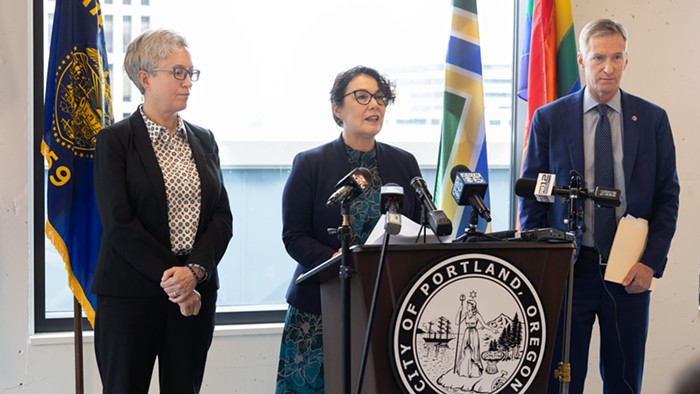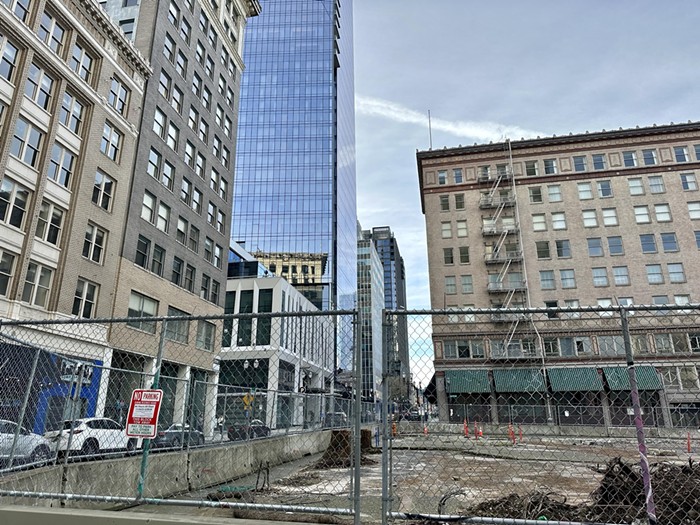
Southeast Portland’s Bullseye Glass had sales of $19.8 million last year according to a Nebraska data firm. Pollution controls on the furnaces state regulators believe have been spewing carcinogens would have cost a fraction of that.
That nearly $20 million sales figure, obtained by the company Infogroup, is interesting given estimates by two pollution-control experts the Mercury spoke with who say that Bullseye could have purchased systems to nearly eliminate the cadmium and arsenic that have escaped its stacks.
According to these industry experts—one a consultant, the other the vice president of a firm that has installed pollution control equipment on 22 glass manufacturers' furnaces worldwide—Bullseye could have addressed its pollution problems for an initial cost of between $500,000 and $1 million. There’d be additional costs from changing the system's filters every three to six years or longer.
Such systems—“baghouse” is the generic name, now being slowly outmoded as many manufacturers turn to ceramic filters—typically last 30 years or more. Spreading the costs over that period, Bullseye could have better safeguarded its neighbors' health for between approximately $17,000 and just over $33,000 a year, the experts say. Again, the firm sold almost $20 million worth of glass last year.
The Mercury reached out to Bullseye co-owner Daniel Schwoerer about the seeming anomaly, but received no reply as of press time.
The 2015 sales figure comes from a report issued by an environmental data firm, ESRI. An ESRI spokesperson, Brian Peterson, confirmed the $19.8 million figure for Bullseye, and said the number had come from Infogroup, which would state only that it "makes 24 million calls annually to verify information with businesses."
If that revenue figure is accurate, there’s little doubt Bullseye could have afforded to better control its emissions.
John Eleftherakis is a vice-president with Illinois-based Filtration Group, which has installed its ceramic air filters on glass furnaces around the globe. Told the general size of Bullseye's annual glass-melt operations as described in its DEQ permit, he provided the estimate of $500,000 to $1 million for Bullseye to scrub its emissions of heavy metals. Though the technology has advanced markedly over the decades, he said systems to handle heavy metals have been available since the 1980s.
Other estimates line up with Eleftherakis’. Robin Frost, owner of Ontario-based Frost Emissions, both consults and helps install pollution control systems. Frost pegged Bullseye's initial costs to install pollution controls at between $500,000 to $1.2 million. This, again, for a system that, with periodic upkeep, lasts for decades.
The relatively low cost of curbing Bullseye’s pollution would no doubt have fanned the flames at the community meeting held to address the issue on Tuesday at Cleveland High School. Anxiety morphed to frustration and then to anger as state officials uttered little of substance for close to three hours in reply to the questions, pleas, and demands of roughly 700 distraught Portlanders.
Tales of illness and death came from the crowd, lining up patiently at two microphones, and officials with the state Department of Environmental Quality (DEQ) and the Oregon Health Authority (OHA) talked knowingly of epidemiology and the intricacies of air pollution permitting.
But there was scant mention of what might be done to safeguard the community from poisonous fugitive emissions from both Bullseye and its north Portland competitor, Uroboros Glass. There were audible groans from the crowd when DEQ permitting chief Dave Monro took the microphone for the umpteenth time and spoke consolingly of the need to gather data and then disseminate it properly.
Among concerns residents brought to officials: the Mercury's revelation Tuesday afternoon that glass-melt furnaces at Bullseye and Uroboros weren’t connected to pollution control devices. A reporter stepped to the microphone at one point to get an explanation from Monro on why the two glass makers lacked such equipment.
Monro replied that he didn’t think, given the high temperatures involved in making glass, that it was even possible to use such a control on their furnaces. The EPA says furnaces contribute "over 99% of the total emissions from a glass plant, both particulates and gaseous pollutants.”
But Monro is wrong, according to Eleftherakis, Frost, and the EPA.
While being interviewed, Frost read the Mercury’s Tuesday story, which reported Bullseye was allowing powder from its glass crushing operations to accumulate on its roof in 2013.
Seeing pictures of the powder spilling out of a pipe and collected in buckets, Frost said, “That's like Eastern Europe 50 years ago.” He added: “That's beyond negligent. It's criminal. It's arrogant.”
The practice of shooting powder onto the roof was described to DEQ in a March 2013 complaint. The agency closed its inquiry in two days, upon hearing from Bullseye that the matter would be dealt with. DEQ saw no need for further investigation.
The agency's seeming obliviousness is evidenced by a 2012 DEQ document, which lists Air Toxics Specialist Sarah Armitage as the contact person. It says, “The Owens-Brockway Glass Plant is the only glass manufacturing facility in the Portland Air Toxics Solutions domain.” That’s not true. Uroboros and Bullseye are at least 40 years old. The ESRI report lists 28 glass manufacturers in Portland.
Interviewed on another matter, Armitage told the Mercury, “I think I didn't know about the risks involved with glass myself. I didn't know about it, though others in the agency may have.”
On another front, Bullseye's British distributor, Glass Studio Supplies, published a statement from Bullseye on its website, and cited "panic buying" and the steps it's taking to limit individual purchases.
Bullseye's release on the site says, "For now, production on the following styles has been suspended (sheet, frit, stringer, etc). If you would like to purchase any of these styles, there is a limit of 5 pieces, per style, per month."
The precise significance of the hopeful term, "per month" is unknown. Does Bullseye have enough cadmium-laden glass already on hand that it can foresee dribbling it out month by month? Or does it anticipate someday making more? Messages to Schwoerer were not returned.
Reached by phone and asked what percentage of Glass Studio Supplies' total stock these 46 "styles" represent, a woman with the company said "I'm not interested in talking to you" and hung up.
Either way, it's a lot of pretty glass. Glass that helped buy Schwoerer and his wife Lani McGregor's home on the north coast of Scotland as well their lavish, art-filled home here in Portland.
Here’s a list of the glass products Bullseye has suspended.
Production on these styles have been suspended:
0024 Tomato Red
0025 Tangerine Orange
0120 Canary Yellow
0124 Red
0125 Orange
0126 Spring Green
0203 Woodland Brown
0220 Sunflower Yellow
0224 Deep Red
0225 Pimento Red
0227 Golden Green
0309 Cinnabar
0310 Umber
0320 Marigold Yellow
0321 Pumpkin Orange
0329 Burnt Orange
0334 Gold Purple
0337 Butterscotch
1022 Red-Orange (rod)
1025 Light Orange Striker
1119 Sienna
1120 Yellow
1122 Red
1125 Orange
1126 Chartreuse
1320 Marigold Yellow
1321 Carnelian
1322 Garnet Red
2020 Clear, Sunflower Yellow Opal
2024 Clear, Red Opal
2026 Clear, Spring Green Opal
2121 Yellow Opal, Deep Forest Green
2123 White Opal, Orange Opal
2124 Red Opal, White Opal
2125 Yellow, Red Striker
3123 White Opal, Orange Opal, Dp. Forest Green
3203 Woodland Brown Opal, Ivory & Black, Soft Rip
4011 AUTUMN: Orange, Yellow and Red on White
4111 AUTUMN: Orange, Yellow and Red on Clear
4112 SUMMER: Green and Yellow on Clear
4424 Red Chopstix
4211 Red, Orange, and Yellow Frit, Orange Streamers
4212 Dark Green, Spring Green, and Yellow Frit, Spring Green Streamers
4220 Canary and Sunflower yellow Frit, Sunflower Yellow Streamers
4223 Yellow, Blue, and Red Frit, Blue Streamers
4224 Red Frit, Red Streamers"
Daniel Forbes is the author of Derail This Train Wreck. He lives in Portland, and can be reached at ddanforbes@aol.com.
MORE COVERAGE:
State Finds Alarmingly High Arsenic, Cadmium Levels Near Two SE Portland Schools
Bullseye Glass Has Suspended Use of Arsenic and Cadmium Because of Air Quality Concerns
Portland Public Schools Is Ordering Air Tests Because of Arsenic, Cadmium Concerns: "We Need A Public Meeting"
Soil Near Bullseye Glass Contains Arsenic and Cadmium—And Other Things Officials Told Parents Thursday
Essential Pollution Controls Lacking at Two Glass Plants Blamed For Cadmium Emissions



















